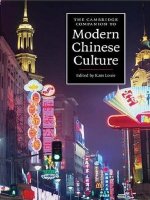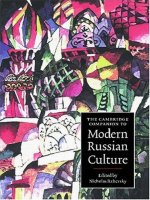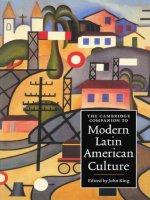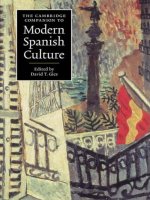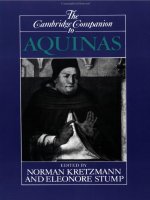the cambridge companion to modern spanish culture
Bạn đang xem bản rút gọn của tài liệu. Xem và tải ngay bản đầy đủ của tài liệu tại đây (8.39 MB, 346 trang )
Cambridge Companions Online © Cambridge University Press, 2006
The Cambridge Companion to
Modern Spanish Culture
This book offers
a
comprehensive account
of
modern Spanish
culture,
tracing
its
dramatic
and
often unexpected
developments from
its
beginnings after
the
Revolution
of 1868
to
the
present
day.
Specially commissioned essays
by
leading
experts provide analyses
of
the
historical
and
political
background
of
modern
Spain,
the
culture
of the
major
autonomous regions (notably
Castile,
Catalonia,
and
the
Basque
Country),
and
the
country's
literature:
narrative,
poetry,
theater,
and the
essay.
Spain's recent development
is
divided into three
main
phases:
from
1868 to the
outbreak
of the
Spanish Civil
War;
the
period
of
the
dictatorship
of
Francisco
Franco;
and
the
post-
Franco arrival
of
democracy.
The
concept
of
"Spanish
culture"
is
investigated,
and
there
are
studies
of
Spanish painting
and
sculpture, architecture,
cinema,
dance,
music,
and the
modern
media.
A
chronology
and
guides
to
further reading
are
provided,
making
the
volume
an
invaluable introduction
to
the politics,
literature, and
culture
of
modern
Spain.
DAVID
T.
GIES is
Commonwealth Professor
of
Spanish
at
the
University
of
Virginia.
He is
author
and
editor
of
twelve books
and
more than seventy scholarly articles
on the
literature
of the
Spanish
enlightenment,
romanticism,
and
the
theater
of
nineteenth-century
Spain.
He is
editor-in-chief
of the
journal
Dieciocko.
Cambridge Companions Online © Cambridge University Press, 2006
Cambridge Companions Online © Cambridge University Press, 2006
Cambridge Companions
to
Culture
The Cambridge Companion to Modern German Culture
editedby
EVA
KoLiNSKYarcd
WILFRIED VAN DER WILL
The Cambridge Companion to Modern Russian Culture
editedby
NICHOLAS RZHEVSKY
The Cambridge Companion to Modern Spanish Culture
editedby
DAVID T. GIES
Cambridge Companions Online © Cambridge University Press, 2006
Cambridge Companions Online © Cambridge University Press, 2006
The Cambridge Companion to
Modern Spanish Culture
edited by
DAVID T. GIES
j
CAMBRIDGE
UNIVERSITY PRESS
Cambridge Companions Online © Cambridge University Press, 2006
PUBLISHED BY THE PRESS SYNDICATE OF THE UNIVERSITY OF CAMBRIDGE
The Pitt Building, Trumpington Street, Cambridge, United Kingdom
CAMBRIDGE UNIVERSITY PRESS
The Edinburgh Building, Cambridge
CB2 2RU,
UK
40 West 20th Street, New York,
NY
10011-4211, USA
477 Williamstown Road, Port Melbourne, vie
3
207,
Australia
Ruiz de Alarcon 13,28014 Madrid, Spain
Dock House, The Waterfront, Cape Town
8001,
South Africa
•V)
Cambridge University Press 1999
This book is in copyright. Subject to statutory exception
and to the provisions of relevant collective licensing agreements,
no reproduction of any part may take place without
the written permission of Cambridge University Press.
First published 1999
Reprinted 2000, 2002,
2003,
2004
Printed in the United Kingdom at the University Press, Cambridge
Typeset in 9/13 pt Lexicon
(The
Enschede
Font
Foundry),
in QuarkXPress^ [SE]
A catalogue record for this book is available from the British Library
Library of Congress Cataloguing in Publication data
The Cambridge Companion to modern Spanish culture / edited by David
T.
Gies.
p.
cm.
Includes index.
ISBN
0521 57408 o (hardback)
ISBN
o 521 57429 3 (paperback)
1.
Spain - Civilization - 20th century.
2.
Spain - Civilization - 19th century.
3.
Arts, Spanish.
4.
Arts,
Modern - 20th century - Spain.
5.
Arts, Modern - 19th century - Spain.
I. Gies, David T., 1945- .
DP48.C233 1999 946'.o7-dc2i 98-35991 cip
ISBN
o 521 57408 o hardback
ISBN
0521 574293 paperback
Cambridge Companions Online © Cambridge University Press, 2006
For JANNA
who
is
discovering
the complexities
of
modern Spanish culture
Cambridge Companions Online © Cambridge University Press, 2006
Cambridge Companions Online © Cambridge University Press, 2006
Contents
List of illustrations xii
Notes on contributors
xiii
Acknowledgements
xvii
Chronology
of major events xviii
Glossary
xxv
Modern Spanish
culture:
An
introduction
1
DAVID
T.
GIES
i Culture: center and periphery
1 What
does
it mean
to
study modern Spanish culture?
u
STEPHANIE SIEBURTH
2 Spain
as
Castile:
Nationalism and national identity 21
E. INMAN
FOX
3
A
cultural mapping of Catalonia 37
TERESA
M.
VILAROS
4
The Basque
Country $4
PHILIP
W.
SILVER
11 Culture and history
5 History,
politics,
and
culture,
1875-1936 67
JOSE
ALVAREZ JUNCO
6 History,
politics,
and
culture,
1936-1975
86
CAROLYN
P.
BOYD
7 History,
politics,
and
culture,
1975-1996
104
SANTOS JULlA
Cambridge Companions Online © Cambridge University Press, 2006
Contents
in Culture and prose
8 Narrative in culture, 1868-1936
123
ROBERTA JOHNSON
9 Narrative in culture, 1936-1975
134
RANDOLPH D. POPE
10 Narrative in culture, 1975-1996 147
JO LABANYI
11 Culture and the essay in modern Spain
163
THOMAS MERMALL
iv Culture and poetry
12 Poetry and culture, 1868-1936 175
RICHARD A.CARDWELL
13 Poetry and culture, 1936-1975 187
ANDREW P.DEBICKI
14 Poetry and culture, 1975-1996 198
CHRIS
G.PERRIAM
v Culture and theater
15 Theater and culture, 1868-1936
211
DRU DOUGHERTY
16 Theater and culture, 1936-1996 222
PHYLLIS ZATLIN
vi Culture and the arts
17 Painting and sculpture in modern Spain 239
JOSE MARTIN MARTINEZ
18 Culture and cinema to
1975
248
KATHLEEN M. VERNON
19 Culture and cinema, 1975-1996 267
PETER W. EVANS
20
A
century of Spanish architecture 278
LUIS
FERNANDEZ-GALIANO
21 Spanish music and cultural identity 287
ROGER D.TINNELL
Cambridge Companions Online © Cambridge University Press, 2006
Contents
xi
22
To
live is to dance 298
LAURA KUMIN
VII
Media
23 The media in modern Spanish culture 309
PHILIP DEACON
Index 318
Cambridge Companions Online © Cambridge University Press, 2006
Illustrations
1 Pablo
Picasso,
Before (1900)
(the Yoshii Gallery, New York, Artists'
Rights Society, New
York)
xxx
2 Pablo Picasso, After
(1900)
(the Yoshii Gallery, New York, Artists'
Rights Society, New
York)
xxxi
3 Spanish Autonomous Regions (Tourist Office of Spain, New York) 13
4 Ignacio Zuloaga, The Mayor
ofTorquemada
(Paris,
Musee Rodin; photo
by Adam Rzepka) 23
5
Espafia,
Civil War poster (Abraham Lincoln Brigade Archives, Brandeis
University) 88
6 The Spanish Royal Family (photo El Pah) 106
7 Francisco Franco (Foto Oronoz, Madrid) 136
8 Title page,
Nueve
novisimospoetas
espanoles,
ed.
J.
M. Castellet 189
9 Poster for Garcia
Lorca's Yerma
(Fundacion Garcia Lorca, Madrid) 213
10 Program cover for Buero Vallej o's
La doble historia
del
Dr.
Valmy
233
11 Still from Berlanga's
Bienvenido,
Mr.
Marshall (Filmoteca Espanola,
Madrid) 250
12 Interior of Rafael Moneo
s
Museo de Arte Romano in Merida (photo by
Lluis
Casals,
Barcelona) 285
13 Compaiiia Nacional de Danza (photo by Paco Ruiz, Madrid) 300
Cambridge Companions Online © Cambridge University Press, 2006
Notes on contributors
JOSE
ALVAREZ
JUNCO is
Prince
of
Asturias Professor
of
Spanish History
at
Tufts
University.
His main publications include La ideologiapolitica del
anarquismo espanol
and
Elemperadordelparalelo.
His
current research
deals with cultural
and
social aspects
of
Spanish political life
in the
late nineteenth
and
early twentieth
centuries,
with special emphasis
on
nation-building
processes.
CAROLYN
P. B o YD
is Professor
and
Chair ofthe History Department
at the
University
of
Texas
at
Austin.
She is
the
author ofPraetorian Politics in
LiberalSpain
and
HistoriaPatria:
Politics,
History,
and
National Identity
in
Spain,
1875-19/5.
RICHARD
A.
CARD
WELL
is Professor
of
Modern Hispanic Literature
at
the University
of
Nottingham,
and
Member ofthe Real Academia
Sevillana de Buenas
Letras.
His studies are concerned with the history
of
ideas
and
comparative
and
post-structuralist theories applied
to
the lyric from romanticism to
the
Civil
War.
PHILIP DEACON
teaches Hispanic Studies
at the
University
of
Sheffield.
His
published research centers on culture
and
ideology
in
eighteenth-
and
twentieth-century
Spain,
principally in
the
fields
of censorship,
drama,
and the
media.
His
edition
of
Moratin's play
El si
de las ninas
appeared
in
1995.
ANDREW P.
DEBICKI
is Dean ofthe Graduate School
and
International
Programs
and
University Distinguished Professor
of
Spanish
at the
University
of
Kansas.
He has held various fellowships (American
Council
for
Learned
Societies,
National Endowment
for the
Humanities,
National Humanities
Center,
Guggenheim);
he has
published seven books
of
criticism about Hispanic
poetry,
as well
as
numerous articles
and
several edited
volumes.
DRU
DOUGHERTY
is Professor
of
Spanish
at the
University
of
California,
Berkeley.
He is the
author
of
Un Valle-Incldn
olvidado,
Valk-Inddny la
Cambridge Companions Online © Cambridge University Press, 2006
Notes
on
contributors
Segunda
Republica,
and
(with Francisca Vilches) La escena madrilena entre
1918y
1926,
El teatro
en
Espana entre la traditiony la
vanguardia,
and
La
escena madrilena entre 1926y
1931.
PETER W.
EVANS
is Professor
of
Hispanic Studies
at
Queen Mary
and
Westfield
College,
University
of
London.
He is
the
author
of
Women on
the Verge
of a
Nervous
Breakdown,
The
Films
ofLuisBunuel:
Subjectivity and
Desire,
and the
co-author (with Bruce Babington)
of
Blue Skies
and
Silver
Linings:
Aspects
of the
Hollywood
Musical,
Affairs
to
Remember:
The
Hollywood Comedy
of the
Sexes,
and
Biblical
Epics:
Sacred Narrative in the
Hollywood
Cinema.
Luis
FERNANDEZ-GALIANO
is
an
architect,
professor
at
Madrid's School
of Architecture, and
editor
of the
journals Arquitectura Viva
and AV
Monographs.
Author
of
several books
-
among them La quimera moderna
and
Elfuegoy la memoria
-
he writes
on
architecture
for
ElPais,
and has
lectured extensively in Europe
and
America.
He has been Cullinan
Professor at Rice
University,
and a
visiting scholar
and
critic
at the
Getty Center in Los
Angeles,
Princeton
University,
Harvard
University,
and the
Berlage Institute
of
Amsterdam.
In 1997
he was
inducted into the Real Academia de
Doctores.
E.
INMAN
FOX
is Professor
of
Hispanic Studies
at
Northwestern
University.
Recipient
of
Spain's Orden
de
Isabel
la
Catolica
and the
Fine Arts Gold
Medal, he has
authored Ideologiay politica en las letras defin
de
siglo
and La
invention
deEspana.
Nacionalismo liberaleidentidad
national,
among many
other studies on contemporary literature
and
thought.
DAVID
T.
GIES
is
Commonwealth Professor ofSpanish at the University
of
Virginia.
He has written or edited twelve books
and
more than 175
articles
and
book
reviews,
and
is
the
editor
of the
journal
Dieciocho.
His
latest publications
are
The Theatre in Nineteenth-Century Spain (also
translated into
Spanish),
an
edition
of
the works
of
Moratin
the
Elder,
and
NegotiatingPast
and
Present,
an homage volume
for
Javier
S.
Herrero.
ROBERTA JOHNSON
is Professor ofSpanish
and
Director
of the
Hall
Center
for
the Humanities
at
the University
of
Kansas.
She
has
published books
on
Carmen
Laforet,
Gabriel
Miro,
and
Azorin's
libraries. She is
also
the
author
of
Crossfire:
Philosophy and
the
Novel in
Spain,
1900-1934.
Her
research has been supported by
the
National
Endowment
for the
Humanities
and the
Guggenheim
Foundation.
SANTOSjULiAis Professor
of the
History
of
Political Thought
and
Director
of
the Department
of
Social History
and
Political Thought at
the
Universidad Nacional de Educacion a Distancia in
Madrid,
Spain.
His
most recent books include Manuel
Azana,
una
biografiapolitica,
Madrid,
historia de una
capital,
and Los
socialistas en
la
politica
espanola,
1879-1982.
Cambridge Companions Online © Cambridge University Press, 2006
Notes
on
contributors
LAURA
KuMiN,a former contemporary Spanish
dancer,
is a
writer,
dance
educator,
and
arts administrator based in
Madrid.
Co-founder
and
director
of the
Certamen Coreografico de
Madrid,
a national showcase
for
new work in contemporary dance
and
ballet,
she
created
the
Madrid Regional Arts Council's dance department
in
1989,
and
directed
it
until
1996.
Jo
LABANYI
is
Professor
of
Modern Spanish Literature
and
Cultural
Studies
at
Birkbeck College
and
Director
of the
Institute
of
Romance
Studies,
University
of
London.
She has published various books
on
nineteenth-century
and
contemporary Spanish
fiction,
has co-edited
Spanish Cultural
Studies:
An
Introduction,
and is
currently completing The
Politics
of the
Family in
the
Spanish Realist Novel
and
a book
on
1940s
Spanish
cinema.
JOSE
MARTIN
MARTINEZ
is
Associate Professor
of
Contemporary
Art at
the University
of
Valencia,
Spain.
He has published several studies
on
the
sculptor Andreu
Alfaro,
as well as articles
and
contributions
to
catalogues
of art exhibits.
THOMAS
MERMALLIS
Professor
of
Spanish
at
Brooklyn College
and the
Graduate School
of the
City University
of
New
York.
He is
the
author
of the
first Spanish critical edition
of
Jose Ortega y
G
assets La rebelion
de las
masas,
Las alegorias delpoderen Francisco
Ayala,
and
La retorica del
humanismo:
la cultura espanola despues de
Ortega.
CHRIS
G.
PERRI
AM
is
Professor of Hispanic Studies at the University
of
Newcastle,
England.
He has written on Francisco
Brines,
Ana
Rossetti, and
Luis Antonio de Villena (Desire
and
Dissent.
An
Introduction
to
Luis Antonio de
Villena).
RANDOLPH D. POPE
is Professor
of
Spanish
and
Comparative Literature
at Washington University
in
St.
Louis,
and the
main editor
of the
Revista deEstudios
Hispdnicos.
He is the
author
of
La autobiografia espanola
hasta Torres
Villarroel,
Novela
de
emergencia:
Espana,
1939-1954,
and
Understanding] uan
Goytisolo.
STEPHANIE
SIEBURTHIS
Associate Professor
of
Romance Studies
and
Women's Studies at Duke
University.
Her
publications include Reading
La Regenta
and
InventingHigh
andLow:
Literature,
Mass
Culture,
and
Uneven Modernity in
Spain.
PHILIP W. SILVER
is Professor
of
Spanish
at
Columbia
University.
He is
the
author
of
numerous studies
on
contemporary Spanish literature
and culture,
including Ortega
asPhenomenologist:
The Genesis of
Meditations
on Quixote,
Nacionalismosy
transicioniEuskadi,
Catalunya,
Espana,
and
Ruin
and Restitution:
ReinterpretingRomanticism in
Spain.
ROGER
D.
T
INN
ELL
is Professor
of
Spanish
and
Chair
of
Foreign
Languages at Plymouth State
College.
He is
the
author
of An
Annotated
Cambridge Companions Online © Cambridge University Press, 2006
Notes on contributors
Discography of Music in Spain before
1650,
Federico
Garcia Lorcay la musica:
Catdlogoy discografia anotados
and
Catdlogo anotado
de
musica espanola
basada en literatura espanola, among other publications.
KATHLEEN
M.
VERN
ON
is
Associate Professor of Hispanic Languages and
Literature and Director of
the
Latin
American and Caribbean Studies
Center at the
State
University of New
York
at
Stony
Brook.
She is
the
author of numerous studies on Spanish
cinema.
Her study of Spanish
women directors, Out of the
Shadows:
Women's Cinema
in
Spain,
1935-1996,
is
forthcoming from Greenwood
Press.
TERESA
M.
VILAROS is Associate Professor at Duke University where she
teaches Spanish Cultural
Studies.
Her publications include El mono del
desencanto: Una critica cultural
de
la transicion espanola
(1973-1993)
and
Galdos:
Invencion de la mujerypoetica
de la
sexualidad.
She
is
currently
working
on
a book
on
post-nationalism, hybridity, and
the
cultures
of
immigration in contemporary Catalonia.
PHYLLIS ZATLIN
is
Professor of Spanish at
Rutgers,
The State University
of New
Jersey.
She has
published
articles,
books,
editions, and
translations related
to
contemporary Spanish theater, cross-cultural
approaches to theater, and contemporary Spanish women
writers.
In
1997 she was
given a special award from the
SGAE
for her work
promoting Spanish theater
in the
United States.
Cambridge Companions Online © Cambridge University Press, 2006
Acknowledgements
It is a cliche - but none the less true for being
so
- that many indi-
viduals and institutions play roles in the creation of any
book.
While it is
impossible to recognize publicly the generosity of every person involved
in this
Cambridge Companion
to
Modern
Spanish Culture, I would be seriously
remiss not to mention those friends and colleagues who helped answer
queries, search for arcane details, track down copyright permissions, or
provide general support during the long gestation period of this
book.
In
addition to the authors of the individual essays, who bore with me
through many months of pestering and editing and clarifying details, I
am grateful to the following people for their kind and selfless contribu-
tions:
Maria Celeste Delgado-Librero, Janna
O.
Gies,
Dorothy
"DJ"
Joba,
Cristina Delia Coletta, Carrie Douglass, David Flores, Vanessa Guibert,
Alison P. Weber, Pedro Alvarez de Miranda, Virginia Catmur, Debbie
McDaniel, and Patty Decourcy.
Cambridge Companions Online © Cambridge University Press, 2006
Chronology
of
major events
1825-1850 Formation and development of Spain's musical theater,
including the zarzuela
1841 Birth of Felipe Pedrell, the most influential figure in Spain's recent
musical history
1850-1867 Publication of Modesto Lafuente's liberal historiography,
Historia general de Espana
1854-1888 Publication of the works of Antonio Canovas del Castillo on the
reign of the Habsburgs and the decadence of Spain
1859 Design of the Pla Cerda in Barcelona
1867 Birth of Manuel de Falla, Spain's most celebrated composer
1868 The September Revolution temporarily ends the Bourbon monarchy;
Queen Isabel II abdicates the throne
1871 Gustavo Adolfo Becquer's
Rimas
appear posthumously
1873 Declaration of the First Republic
1875 Restoration of the Bourbon monarchy under Alfonso XII;
Nunez de Arce publishes
Gritos
de combate
1876 Founding of the Institucion Libre de Ensenanza
1882 Publication of Ernest Renan's "Qu'est-ce qu'une nation?"
1883 Publication of
La
cuestion
palpitante
by Emilia Pardo Bazan
1884 Publication of
LaRegenta,
by Leopoldo Alas
("Clarin")
1885 Alfonso XII dies at the age of twenty-eight
1886-1887 Publication of Eortunatayjacinta, by Benito Perez Galdos
1890
1
May:
First May Day celebration
1892 Sabino Arana Goiri publishes
Bizcayaporsu
independencia;
plan for the
Ciudad Lineal in Madrid by the architect Arturo Soria; terrorist
attempt against General Martinez Campos in Barcelona
1894 Basque Nationalist Party formed; Jacinto Benavente premieres his
play,
Elnido
ajeno;
Angel Pericet Carmona, patriarch of several
generations of distinguished dancers, choreographers, and teachers,
opens his first dance academy in Seville
Cambridge Companions Online © Cambridge University Press, 2006
Chronology
of
major events
1895
Publication
of En
torno
al
casticismo,
by
Miguel
de
Unamuno;
beginning
of the war in
Cuba
1896 The
publication
of
Ruben Dario's Prosas profanas
and
Los raws attracts
wide attention
in
poetry
circles;
first cinema program shown
in
Madrid
and
Barcelona;
first Spanish film shot
by
A.
Promio Jimeno
1897
Angel Ganivet publishes Idearium
espanol;
Prime Minister Antonio
Canovas
del
Castillo assassinated
1898
Defeat
in the
colonial wars
as
symbolic
of the
"Problem
of
Spain";
Adria Gral founds
the
Teatre
Intim,
an
amateur group devoted
to
"artistic
theater"
in
Barcelona;
Ganivet commits suicide
in
Helsinki
1899-1911 Publication
of
Rafael
Al
tamira's Historia
de
Espanay de la civilization
espanola
1901 The premiere of Benito Perez Galdos's
Electra
is a political sensation in
Madrid
1902 Accession to the throne of King Alfonso XIII; several important books
appear: Manuel Machado's Alma, Juan Ramon Jimenez's Arias tristes,
Miguel de Unamuno's Amory
pedagogia,
Azorm's
La
voluntad,
Ramon
Maria del Valle-Inclan's
Sonata
de
otono,
and Baroja's
Camino
de perfection
1903 Publication of Antonio Machado's
Soledades
1904 Jose Echegaray wins the Nobel Prize for Literature
1906
31
May: King Alfonso XIII marries Victoria Eugenia of Battenberg,
grand-daughter of Queen Victoria of England; failed anarchist
attempt on the lives of the royal couple
1907 Picasso paints Les Demoiselles d'Avignon, which initiates the Cubist
revolution in painting
1908 Publication of El
Greco
by M.
B.
Cossio
1909 Hispano Films builds first film studio in Spain
1909
26
July:
Beginning of "Tragic Week" repressions in Barcelona
1910 The Centro de Estudios Historicos is founded by the government;
publication of Ramon Menendez Pidal's
La epopeya castellana a traves de
la literatura
espanola;
publication of the first "Clasicos Castellanos"
1912-1915 Publication of essays by Azorin, collected as Lecturas espanolas,
Clasicos y
modernos,
Los valores
literarios,
and Al mar
gen de
los clasicos
1914 Publication of Meditaciones
del
Quijote,
by Jose Ortega y Gasset; Antoni
Gaudi creates the Parque Guell in Barcelona
1914-1918 Spain remains officially neutral in the First World War, but
divides loyalties between Allies and Germans
1915 El amor
brujo,
Manuel de Falla's first flamenco ballet, premieres at the
Teatro Lara in Madrid with Pastora Imperio in the lead role
1916 Juan Ramon Jimenez publishes
Diario de
unpoeta
recien casado
1917 General strikes against government lead to political crisis; Gregorio
Martinez Sierra opens the Teatro de Arte in Madrid's Teatro Eslava;
Antonio Machado publishes an enlarged edition of
Campos de Castilla
Cambridge Companions Online © Cambridge University Press, 2006
Chronology
of
major events
1920 Ramon del Valle-Inclan publishes Luces
de bohemia
in the political
review Espana
1921 Publication of La
Espana
invertebrada,
by Jose Ortega y Gasset; Federico
Garcia Lorca publishes
Libro
depoemas;
new outbreak of the Moroccan
War results in massive slaughter of Spanish troops
1922 Celebration in Granada of the Concurso de Cante
Jondo,
an event
which helped to restore the prestige of Spain's gypsy
music;
Jacinto
Benavente is awarded the Nobel Prize for Literature
1923 Military coup
d'etat
led by General Jose Miguel Primo de Rivera
abolishes the 1876 constitution and initiates a seven-year dictatorship;
first regular radio programs broadcast from Madrid's Radio Iberica
1925 Ortega publishes
La deshumanizacion
del
arte,
marking an important
moment in the history of vanguard art
1926 The experimental theater group El Mirlo Blanco, directed by Cipriano
de Rivas
Cherif,
is founded in Madrid
1928 Ernesto Gimenez Caballero founds the Cine-Club Espana; Antonia
Merce, the incomparable "La Argentina," presents her Ballets
Espagnols de La Argentina, the first repertory Spanish dance
company, in Paris
1929 The "talkies" arrive in Madrid; the Teatro Apolo - "cathedral of the
genero
chico"
-
closes;
Mies van der Rohe designs the German Pavilion
for the World Fair in Barcelona
1930 Civil uprisings culminate in the fall of Primo de Rivera
1931 General elections result in the abdication of Alfonso XIII and the
proclamation of the Second Republic
1933 Federico Garcia Lorca's first commercial hit, Bodas de
sangre,
premieres
in Buenos Aires
1934
5
October: Revolutionary uprisings in Catalonia and Asturias
1935 Sound technology for film established in Spain
1936 Eduardo Torroja designs the Zarzuela racetrack in Madrid
1936 17 July: An insurrection begun in Morocco against the Republican
government initiates the Spanish Civil War
1936 29 September: General Francisco Franco is named General-in-Chief
and Chief of State in the Nationalist zone
1936-1939 During the Spanish Civil War Luis Bunuel directs films for the
Republican
side;
Benito Perojo and Florian Rey direct musical
features in Berlin
1937 The Spanish Pavilion, designed by Josep Lluis Sert, opens in Paris
1937
17
April:
Unification of FET
y
de
las
JONS
1938 Wartime press law initiates subservience of all publications to
Francoist ideology, imposing censorship and strict control; the
Supreme Board of Film Censorship created
Cambridge Companions Online © Cambridge University Press, 2006
Chronology
of
major events
1939
1
April:
Victory of the nationalists; end of the Civil War, beginning of
the Franco regime
1940S-1950S Age of the
copla
and the
cancion
ligera;
beginning of several
important Spanish music festivals (Granada, Santander, San
Sebastian)
1941 Escuela Oficial de Periodismo established to train and control
journalists; obligatory dubbing into Spanish of all foreign films is
mandated
1942 Camilo Jose Cela publishes Lafamilia
dePascualDuarte;
creation of the
official Spanish newsreel, the Noticiario Cinematografico Espaiiol,
called the "NO-DO"; showing of the newsreel before the feature film
is made compulsory in all cinemas within Spain
1944 Carmen Laforet publishes the Premio Nadal-winning novel,
Nada;
publication of Damaso Alonso's
Hijos de la ira
and Vicente Aleixandre's
Sombras
delparaiso;
first issue of
Espadafia
appears
1947 Founding of the national film school, the IIEC
1947 6 July: Referendum on the Law of Succession
1949 Premiere of Antonio Buero Vallej o's play,
Historia de
una
escalera
1951 Cela's ground-breaking
La colmena
is published in Buenos Aires;
Ministerio de Informacion y Turismo created, reasserting total
government control of media; a week of Italian neo-realist films is
shown at Madrid's Institute of Italian Cultures
1952 Publication of the
Antologia consultada de lajovenpoesia espanola
1953 Publication of Claudio Rodriguez's poetry collection,
Don de la
ebriedad;
premiere of Alfonso Sastre's play,
Escuadra hacia la muerte
1953
27
August: Concordat signed with the Vatican
1953 26 September: Bilateral Pact of Madrid signed with the United States
1955 Publication of Bias de Otero's
Pido
lapazy
lapalabra;
Salamanca
Conversaciones de Cine; Bardem's
Muerte de un ciclista
wins the Fipresci
Prize at the Cannes Film Festival
1956 Rafael Sanchez Ferlosio publishes Eljarama; government-run
television service
(TVE)
launched, adding a second channel in 1965
1957 Three important artist collectives are formed: Grupo Parpallo
(Valencia), Grupo El Paso (Madrid) and Equipo
57
(Paris and Cordoba)
1958 Eduardo Chillida (sculpture) and Antoni Tapies (painting) are
awarded top prizes at the Venice Biennale
1959 ETA (Euskadi ta Askatasuna) founded
1959 21 July: Economic stabilization plan announced
1960s Spanish rock music comes of
age,
with a multitude of groups and
stars,
and the accompanying artists who write protest music (against
the Franco dictatorship)
1960 Appearance of Jose Maria Castellet's anthology Veinte
anos depoesia
Cambridge Companions Online © Cambridge University Press, 2006
xxii
Chronology of major events
espanola;
Bunuel's film
Viridiana
wins the Golden Palm Award at
Cannes;
two major art exhibits - "New Spanish Painting and
Sculpture"
at
MOMA
in New York and "Before
Picasso,
After
Miro"
at
the Guggenheim Museum in New York - focus international
attention on Spanish artists
1961 Luis Martin-Santos publishes
Tiempo
de silencio
1962 Merce Rodoreda's novel
Lapla§a
delDiamant
is
published; premiere of
Lauro Olmo's play
La
camisa;
Els Joglars theater group founded
1964 Gabriel Aresti publishes Hani
eta
herri (Stone and
[a]
People)
1966 New
laws
of the press significantly relax the effects of
censorship;
first
Spanish stagings of the plays of Bertold Brecht
1966
14
December:
Referendum on the Organic
Law
of the State
1967 First annual Sitges Theater Festival
1968 Euskera
Batua,
the first unified standard for the Basque
language,
is
developed by the Basque
Academy;
Spanish premiere of Weiss's play
Marat-Sade
1969 22 July:
D.
Juan Carlos de Borbon designated as Franco's successor
1970 Juan Goy tisolo publishes
Reivindicacion
del conde don
Julian;
publication
of Jose Maria Castellet's
Nueve
novisimos
poetas espanoles
1973 Victor Erice directs El
espiritu de la
colmena;
Antonio Gades presents his
choreographic interpretation of Garcia Lorca's
Bodas desangre
1973 20 December: Assassination of Admiral Luis Carrero Blanco by ETA
militants
1974 Carlos Saura's film Laprima
Angelica is
awarded the Special Jury Prize at
Cannes, while in Madrid eight right-wing youths attempt to steal the
film. Two months later,
a
bomb explosion sets fire to a cinema in
Barcelona where the film is being shown
1975 Carlos Saura directs
Crta cuervos
and Jose Luis Borau directs
Furtivos;
Jorge de Oteiza publishes
jQuosque
tandem
AEnsayo de interpretacion
estetica
del
alma
vasco;
censorship rules allow nudity on stage
1975 20 November: Death of Francisco Franco and end of dictatorship
1975
22
November: Juan Carlos I proclaimed king of Spain
1976 Juan Marse's novel
5/
te
dicen
que
cat
confiscated on its publication in
Spain (it had been previously banned in Spain and published in
Mexico);
Adolfo Suarez named Primer Minister; launch of the
innovative independent daily newspaper, El Pats
1977 Vicente Aleixandre wins the Nobel Prize for Literature; establishment
of the Spanish Musicological Society; amendment to the 1976 Law of
Political Reform formally abolishes censorship; Spanish Communist
Party legalized
!977 15
June:
The first general elections since February
1936
are held
1977
25
October: The Pactos de Moncloa are signed in Madrid; Law of
Political Reform signed
Cambridge Companions Online © Cambridge University Press, 2006
Chronology of major events
1978 Inauguration of the Centro Dramatico Nacional; creation of the Ballet
Nacional de Espana, Spain's national dance company
1978 6 December: The Constitutional Referendum is passed by an
overwhelming popular vote
1979 The Basque Autonomous Community receives its Gernika Autonomy
Statute; Editorial Catedra publishes the anthologyJovenpoesia
espanola;
Spain begins negotiations for incorporation into the
European Economic Community; founding of the Ballet Nacional
Clasico (later known as the Ballet del Teatro Lirico Nacional) under
the direction of Victor Ullate
1980s "La movida"
(a
strong new wave of pop music and culture); rise of
regional and city authorities' cultural promotions
1981 Antonio Gades and Carlos Saura collaborate on a film version of Bodas
desangre,
the first of a trilogy of joint works which includes
Carmen
and
Elamorbrujo;
Picasso's "exiled" painting,
Guernica,
returns to Spain
from its temporary home at MOMA in New York
1981
29
January:
Adolfo Suarez resigns as Prime Minister
1981
23
February: Attempted coup d'etat by Antonio Tej ero and
disgruntled Civil Guard troops
1982 The first annual Feria Internacional de Arte Contemporaneo, "Arco
'82,"
takes place in Madrid; the young painter Miquel Barcelo shows
his work at the Dokumenta 7 in Kassel, Germany
1982 28 October: The PSOE wins the general elections; Felipe Gonzalez is
elected Prime Minister
1983 Regional television begins in the Basque Country
1984 Creation of the National Center for New Tendencies of the Stage;
regional television begins in Catalonia
1985 Julio Llamazares publishes his first novel,
Luna de
lobos;
Spain signs
into the European Community
1986 Visor (Madrid) publishes the anthology
Posnovisimos;
Hiperion
(Madrid) publishes a second revised edition of
Las diosas
blancas:
Antologia de
la
jovenpoesia espanola
escritapor
mujeres;
Antonio Munoz
Molina publishes his first novel,
Beatusllle;
the referendum ratifying
Spain's incorporation into NATO is passed; the Museo de Arte
Romano in Merida created by Rafael Moneo; the modern art museum,
Centro de Arte Reina Sofia, opens in Madrid
1987 Torremozas (Madrid) publishes
Panorama antologico depoetisas espanolas
1988 Three independent, commercial television companies allowed to
compete with state-run RTVE
1989 Basque author Bernardo Atxaga wins the National Prize for Literature
with the Spanish version
ofObabakoak;
Camilo Jose Cela wins the
Nobel Prize for Literature; in Valencia the Instituto Valenciano de Arte
Moderno opens
Cambridge Companions Online © Cambridge University Press, 2006
Chronology of major events
1990 Alvaro Pombo publishes his major novel, El
metro deplatino
iradiado;
Nacho Duato is invited to head the Compaiiia Nacional de Danza
1992 Spain hosts the Olympic Games (Barcelona), the International Expo
(Seville), and the Cultural Capital of Europe
(Madrid);
Visor publishes
the anthology
Fin
de siglo
1995 The National Literary Prize first awarded to a novel in Catalan (Carme
Riera's Dins el darrer blau)
1996 The PP wins the general elections, replacing the
PSOE;
Jose Maria
Aznar
is
elected Prime Minister; Editorial Critica (Barcelona)
publishes
La nuevapoesia
(1975-1992);
Antonio Munoz Molina elected to
the Spanish Real Academia
1997 October: Inauguration of Frank
O.
Gehry's Bilbao Guggenheim
Museum; reopening of the Teatro Real opera house in Madrid




